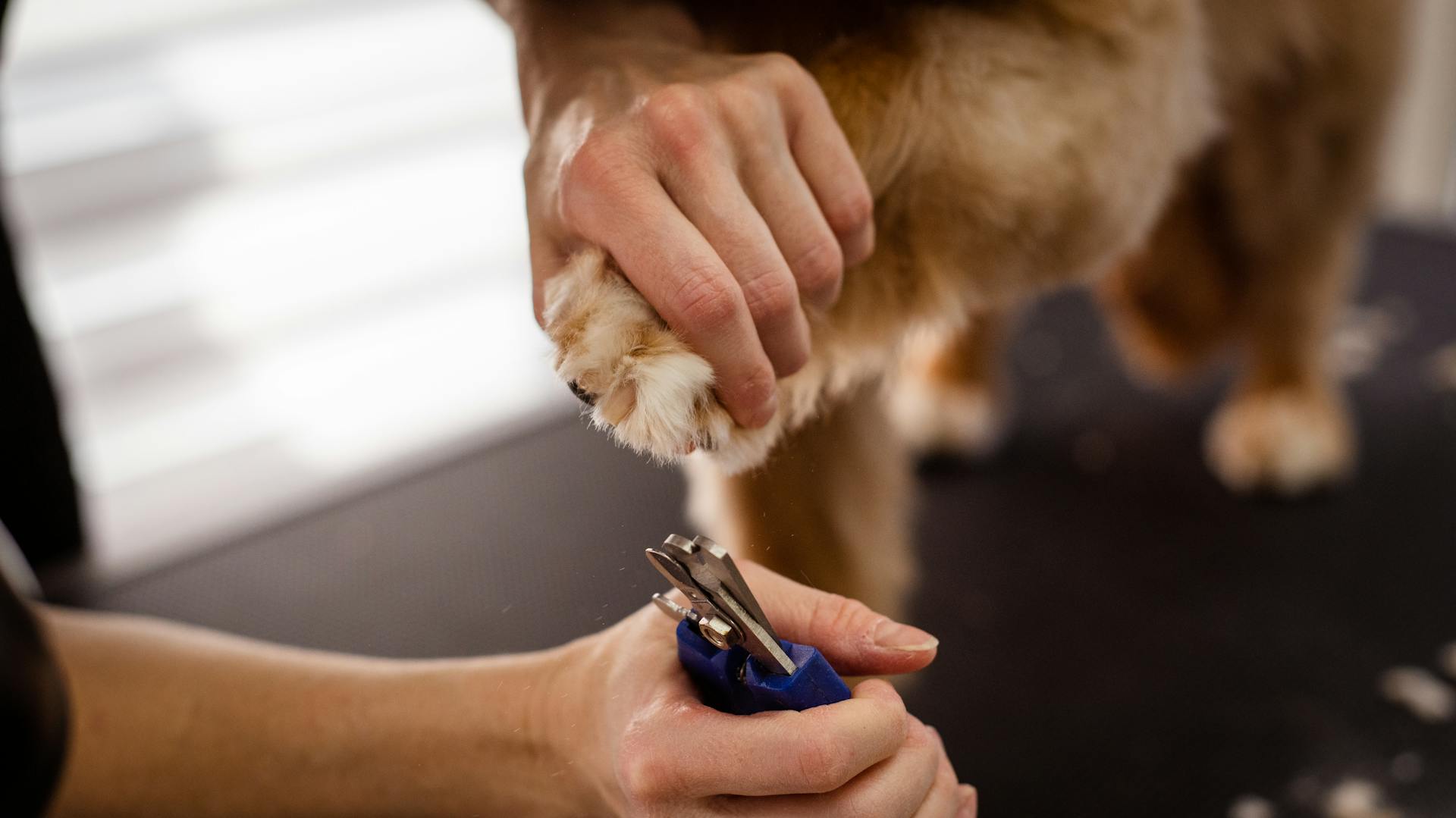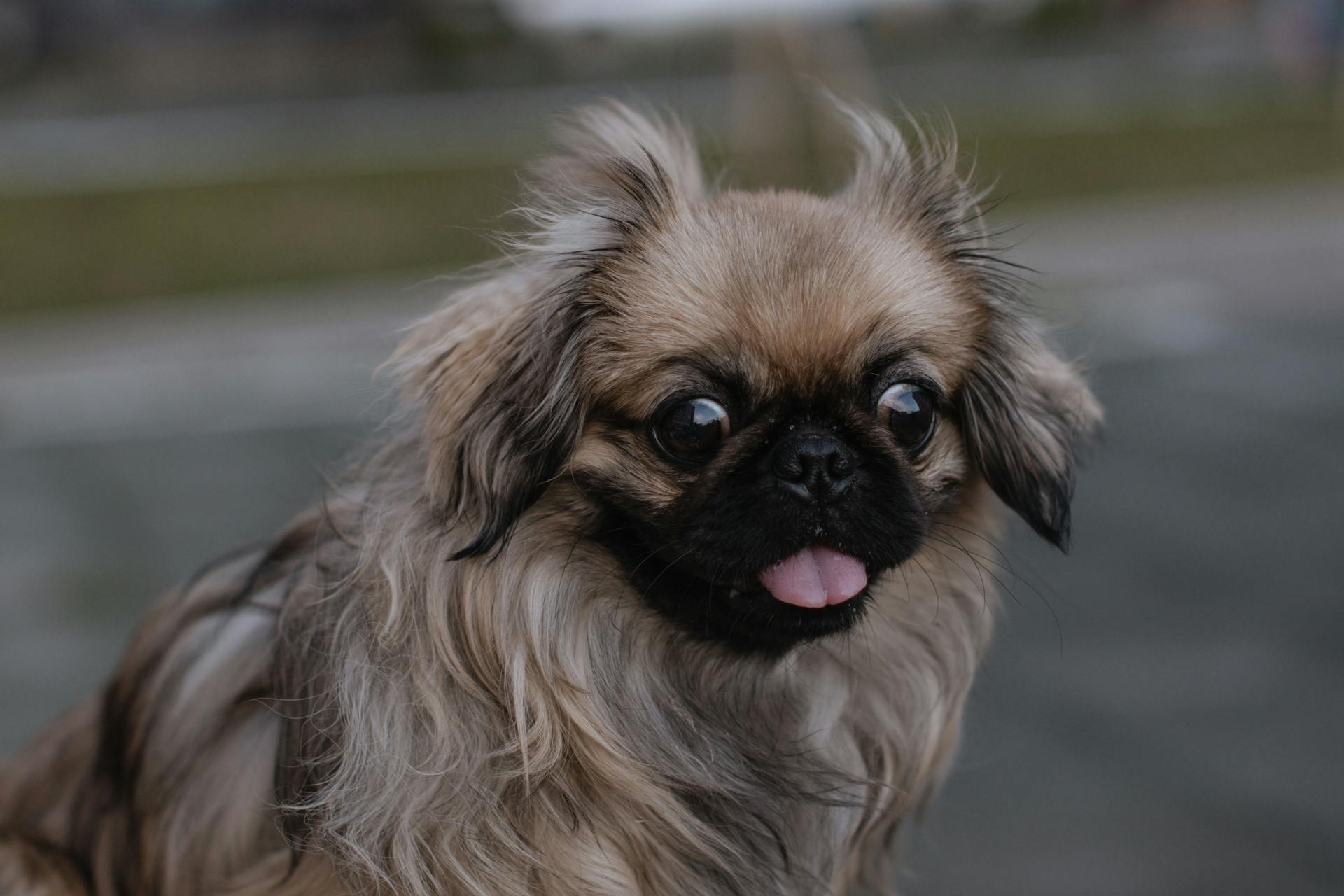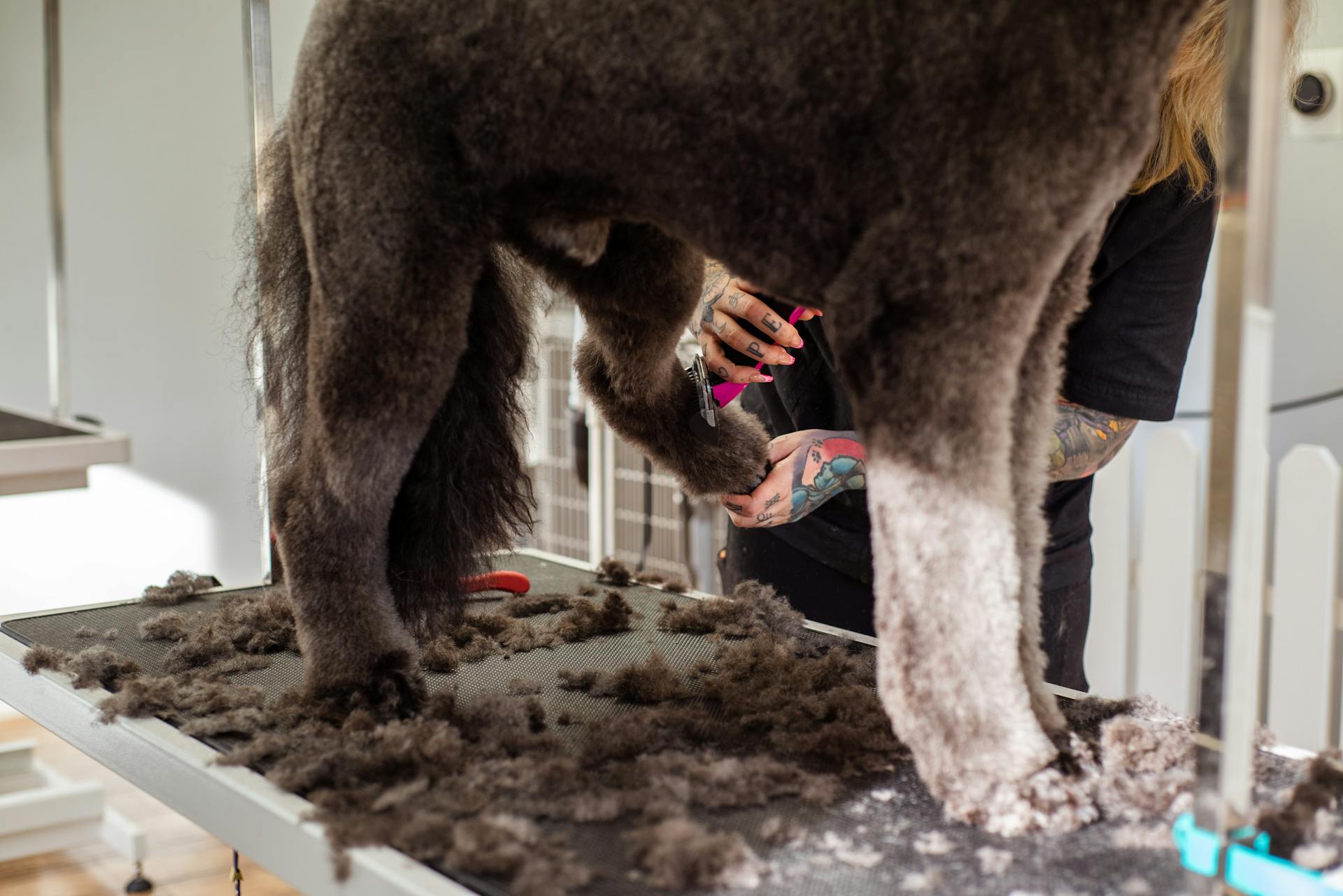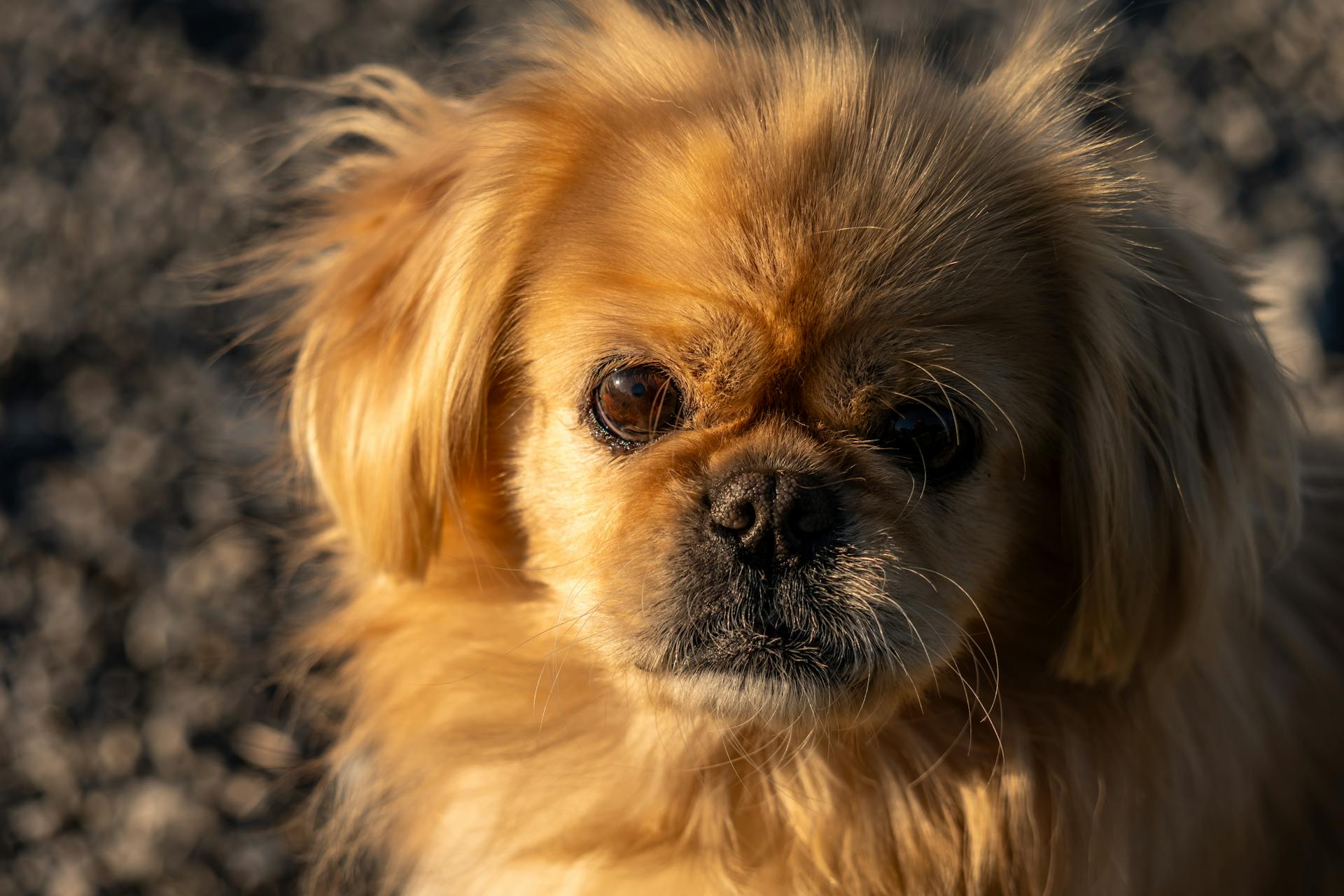
The Pekinese temperament is a unique blend of loyalty and stubbornness. They can be wary of strangers and may take time to warm up.
To build trust with your Pekinese, start with short, gentle interactions and gradually increase the duration and intensity. Consistency is key.
Pekinese are intelligent and trainable, but they can be resistant to change. Positive reinforcement techniques, such as treats and praise, work best.
Regular grooming is essential for Pekinese, as their long hair can easily become matted and tangled. Brushing should be a daily habit to prevent knotting.
Check this out: Pekinese Mix
Origin and History
The Pekingese breed has a rich and fascinating history that spans over 2,000 years, originating in China during the Shu Dynasty. The breed was created by Buddhist monks who selectively bred small dogs to create a miniature lion, a symbol of their faith.
The Pekingese was a sacred symbol in China, reserved exclusively for the imperial family, and was considered a status symbol. They were only allowed to be owned by members of the Chinese Imperial Palace, and removing them from the palace was punishable by death.
You might like: Tibetan Mastiff China
In the 19th century, the Pekingese was introduced to Europe after the British plundered Chinese palaces during the Second Opium War. One of the Pekingese, a bitch called "Looty", was presented to Queen Victoria as a gift in 1861.
The breed was first recognized by the British Kennel Club, and it wasn't until the early 20th century that the Pekingese became popular in other countries. Today, the breed is still cherished for its elegance, dignity, and self-confidence, qualities that were instilled in them by their imperial past.
Additional reading: British Bull Terrier Puppy
Characteristics and Care
The Pekingese is a small dog with a big personality. They have a shoulder height of approximately 20-25 cm and a maximum weight of 5-5.4 kg, although most specimens weigh between 3-5 kg.
Their compact size makes them well-suited for indoor living, but they do require regular walks. However, excessive activity can be challenging for them due to their short legs and front-heavy build.
Pekingese have a dense, sometimes long coat with a thick undercoat that needs to be brushed regularly to prevent matting. Daily grooming against the direction of hair growth is essential, and bathing should only be done in exceptional cases to prevent damage to their skin and coat.
Their eyes and ears should be regularly checked and cleaned, and their claws shortened to an appropriate length. They also have fur on their paws and between their toes, which may need to be trimmed to prevent hindrance while walking.
Here are some essential care tips for Pekingese owners:
- Brush their coat daily to prevent matting.
- Check and clean their eyes and ears regularly.
- Shorten their claws to an appropriate length.
- Trim their fur on paws and between toes if necessary.
It's also crucial to keep an eye on their temperature, as they can quickly overheat due to their dense coat. Providing shade or cool indoor areas is essential, especially in summer.
Care and Upkeep
The Pekingese is a unique breed that requires regular grooming to prevent matting and tangling of their thick coat. They should be brushed daily, right down to the skin, to prevent mats and shedding is fairly light.

To keep their coat healthy and presentable, daily brushing is essential, and they require a trip to the groomer every 8-12 weeks.
Their heavy wrinkle over their nose should be cleaned and dried daily, as left wet, it can become smelly and infected. The prominent eyes should be checked regularly for abrasions and can get dry due to their short muzzle.
Pekingese need to run and jump around daily, but their exercise needs are modest and can be met even inside an apartment. However, they can overheat, which is why some owners travel with ice packs or ice pillows.
Here are some key grooming tasks to keep your Pekingese healthy:
- Brush their coat daily
- Clean their wrinkle and eyes daily
- Trim their nails regularly
- Check their ears and paws for foreign matter
Their compact size makes them well-suited for indoor living, but they do need regular walks to stay healthy. In cold climates, their long fur in the rear end (aka the "trousers" or "skirt") may accumulate clumps of snowballs.
Pekingese are prone to heatstroke when exposed to high temperatures, so it's essential to keep them cool. They should have access to plenty of water before, during, and after exercise to prevent overheating and dehydration.
Sleeve Pekingese
The Sleeve Pekingese was a true miniature of the standard-sized dog, and was also known as the Miniature Pekingese. It was bred to be as small as possible, with some weighing as little as 3-4 pounds.
In Britain, the term Sleeve was applied to a miniature Pekingese no more than 6-7 pounds in weight. These small dogs were often carried in the capacious sleeves of the robes worn by members of the Chinese Imperial Household.
The Sleeve Pekingese was considered a defensive weapon if needed, and was bred with the intention of stunting their growth. This was done by practices such as giving puppies rice wine, holding newborns tightly for hours at a time, or putting the puppies into tight-fitting wire mesh waistcoats.
Dowager Empress Cixi apparently forbade these practices, but they were still used by some breeders.
Temperament and Personality
Pekes have a royal demeanor and are loyal, alert, and assertive, making excellent watchdogs.
They are not overly demonstrative, but are affectionate and great companions for gentle children and older adults alike.
Pekes are often aloof toward strangers, but get along well with other dogs and pets.
They are not inclined to strenuous activity and may not be active enough for owners wanting a vigorous outdoor companion.
Despite their small stature, Pekes can be surprisingly strong-willed and determined.
This breed prefers to be with their people at all times and will not thrive if left alone for very long.
They have a comical side with their family, but can be reserved with strangers, showcasing their dignified and stately nature.
Pekes are clever and brave in their own way, but also stubborn and one of the hardest breeds to train.
Training Pekingese Dogs
Training Pekingese dogs requires a gentle and patient approach. They respond well to kind dog training methods using food or toys as rewards.
Pekes are intelligent dogs, but they can be stubborn at times. You'll need to work hard to motivate them to do as you ask.
A good solid recall is essential for a well-behaved Pekingese. Teach your Peke to walk nicely on the lead without pulling, and it will make walks a more enjoyable experience for both of you.
Socialising your Pekingese with other animals and people while they're young is crucial. It will help them become confident and calm in new situations.
You can use food or toys to reward good behavior in your Pekingese. This will help them associate training with positive outcomes.
A different take: Will Shiba Inu Hit 1 Cent
Health and Grooming
The Pekingese is a beautiful breed, but they do require regular grooming to prevent matting and keep their coat looking its best. Daily grooming is essential, especially around the mane, elbows, behind ears, and chest.
Their dense coat needs to be brushed regularly, against the direction of hair growth, to reach the undercoat. This will help prevent matting and keep your Pekingese looking healthy.
Bathing should be done sparingly, as it can take a long time for their coat to dry completely. If you do need to bathe your Pekingese, make sure they have a warm, draught-free place to dry off in.
For your interest: Schnauzer Looking Dogs
It's also crucial to regularly check and clean your Pekingese's eyes, ears, and skin folds. This will help prevent infections and keep them looking their best.
Their claws need to be shortened regularly, especially if they walk a lot on soft ground. Dirty paws after a walk can easily be cleaned in the shower.
The Pekingese is prone to certain health issues, including neurological and cardiovascular defects, as well as breathing problems caused by their brachycephalic face.
In Popular Culture
The Pekingese has made appearances in popular culture, showcasing its charm and unique characteristics. Chapter 85 of the 16th-century novel Journey to the West features a golden-haired happa puppy, a predecessor of the Pekingese, in the Fragrance-Draping Hall in heaven.
In literature, the Pekingese is a main contender in T. S. Eliot's humorous poem, The Awefull Battle of the Pekes and the Pollicles, which was later adapted for the musical Cats.
You might be familiar with the Pekingese as Trickie Woo, a spoiled yet good-natured dog in James Herriot's semi-autobiographical books and television adaptations, All Creatures Great and Small.

In the movie Crazy Rich Asians, Goh Peik Lin's family owns three Pekingese named Astor, Vanderbilt, and Rockefeller.
Here's a quick rundown of the Pekingese's appearances in popular culture:
- Journey to the West (16th-century novel)
- The Awefull Battle of the Pekes and the Pollicles (humorous poem by T. S. Eliot)
- All Creatures Great and Small (books and television adaptations)
- Crazy Rich Asians (movie)
Ratings
The Pekinese is a beloved breed, but it's essential to consider their needs and characteristics before bringing one home. They're a great choice for families, scoring 5/5 in the family-friendly category.
Their exercise needs are relatively low, making them suitable for apartment living. With a rating of 2/5 in the exercise needs category, they don't require a lot of physical activity.
Pekinese are known to be relatively easy to train, but consistency and patience are key. Their trainability rating is 3/5.
However, they can be prone to separation anxiety, scoring 3/5 in the tolerates being alone category. This means they may not be the best fit for owners with busy schedules.
If you're considering getting a Pekinese, it's worth noting that they can get along with other pets, but they may not be the most social breed. Their rating in the likes other pets category is 2/5.
For more insights, see: 2 Ingredient Frozen Dog Treats
In terms of energy level, Pekinese are relatively low-maintenance, scoring 2/5. This makes them a great choice for owners who don't want to engage in high-energy activities.
Grooming needs are moderate, with a rating of 2/5. Regular grooming is necessary to prevent matting and tangling of their fur.
One thing to be aware of is their shedding, which can be significant. With a rating of 4/5, they may require more frequent grooming during shedding season.
Here's a quick summary of their ratings:
Frequently Asked Questions
Is Pekingese a Shih Tzu?
No, the Pekingese is not a Shih Tzu, but rather one of the breeds believed to have contributed to the Shih Tzu's origins. The Shih Tzu is a distinct breed that originated from Tibet, with a unique ancestry that includes the Pekingese and Lhasa Apso.
Do Pekingese bark a lot?
Pekingese are prone to excessive barking due to their protective and communicative nature. They may bark to alert their owners, respond to fear or anxiety, or simply because they have a strong instinct to vocalize.
Is Pekingese a good family dog?
Yes, Pekingese are well-suited for loving families with gentle children, as they bond closely with their humans and thrive in a calm, affectionate environment.
Why are Pekingese so rare?
Pekingese are not extremely rare, but their declining popularity makes them less commonly seen than other toy breeds. Their perceived rarity is largely due to their decreasing popularity rather than a true scarcity.
Featured Images: pexels.com

